Please note: Special public hours – 10 AM to 5 PM – on Thursday, May 9
Please note: Special public hours – 10 AM to 5 PM – on Thursday, May 9
Mandalas are maps of Buddhist visionary worlds.
Minutely detailed and saturated with philosophical meaning, these works (most often paintings or sculptures) are a feast for the eyes and the mind—nested squares and circles are arrayed to represent the center of the cosmos and the four cardinal directions. For Buddhist practitioners, however, mandalas are not just images to view, but worlds to enter—after recreating the image in their mind’s eye, meditators imaginatively enter its realm.
But is it possible to have this experience without years of meditative discipline?
Enter the Mandala says yes. In this exhibition, 14th-century paintings align a gallery with the cardinal directions, transforming open space into an architectural mandala—a chance to experience the images in three dimensions, to dwell in the midst of the cosmic symbols and be transported to another world. Visitors can literally “enter the mandala,” exploring places in the cosmos—and perhaps themselves—that might otherwise remain invisible.
“Lightning Vehicle” is one translation for Vajrayana, a form of Buddhism, and mandala-related artworks belong especially to this way of enlightenment (or “vehicle”).
In the Lightning Vehicle, “lightning” is one common translation of the word vajra. Also translated as “diamond,” vajra is translated as “lightning” in this exhibition to emphasize the power and swiftness of the Lightning Vehicle’s art and philosophy. These types of artworks are displayed in this exhibition. Artworks from across cultures influenced by Lightning Vehicle thought are displayed in this exhibition.
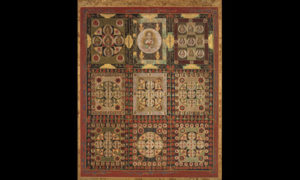
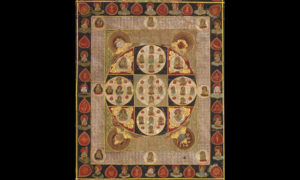
Lightning Vehicle mandalas are geometric meditation maps. Visually, they are made of a series of nested squares and circles. Above is an example from an object in our collection. A mandala’s form brings order to space, which would otherwise be infinite and invisible. Mandalas thus make it possible to ‘know where you are in the cosmos.
Beyond this, mandalas also organize inner space, so that you know ‘where you are’ psychologically. In Lightning Vehicle thought, each person is dominated by one of five pollutants: hatred, lust, pride, jealousy and delusion. A specific ritual procedure determines which pollutant a person is dominated by, after which the person teaching about the mandala makes a meditative prescription. Then, the mandala becomes a map in another sense: the meditator first visualizes the entire mandala, and then enters the visualization.
Once inside, it is all about a series of transformations ideally leading directly towards the center of the mandala. There, the meditator can fundamentally transform the nature of experience. In one sense, this happens when psychological poisons are transmuted into their equal and opposite “wisdom” (prajna). In a more fundamental sense, transformation occurs when the meditator identifies with the figure at the center, who is always a symbol of enlightened awareness . This procedure is described as “taking the result as the path,” in which one sees oneself directly as already enlightened.
The journey ‘into’ the world of the mandala is a visionary journey taken in the mind’s eye – and the imagery of the mandala guides it.
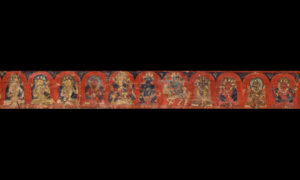
At the outset of the journey, the student encounters any number of fierce guardian figures. In many early Tibetan mandalas, such fierce guardians appear at the bottom of the painting. In later mandalas, a series of cemeteries, a ring of fire, and a circle of golden thunderbolts each may separate the visualized world of the mandala from the ordinary world.
Once inside, a strange sight greets the meditator: a cubic palace seated on top of two crossed vajras , which itself appears on an immense lotus. The four quadrants of the palace are oriented to the cardinal directions and color-coded to match them.
The meditator enters this palace from the east. Here, she encounters the cosmic Buddha Akshobhya, the “Unshakeable One.” His hand gesture is the same as that made by the historical Buddha Shakyamuni when he began his career as a Buddha: the earth-touching gesture that defeated the armies of Mara. The symbolism of the unshakeable vajra seat, located at the foot of the bodhi tree, is the linchpin between the two.
Then the meditator proceeds clockwise to the south, west, north and center. The visualization culminates as meditators transfer their own awareness into the visualized body of Vairochana.
Five directional Buddhas are found throughout regions of Asia influenced by Lightning Vehicle thought.
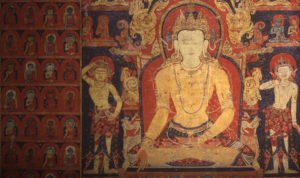
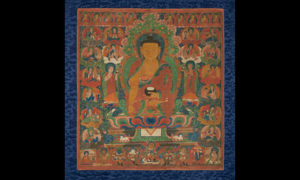
Given this profusion of Buddhas, philosophers adopted the graphic form of the mandala as a framework for organizing and guiding complex meditation. They then mapped an older Buddhist psychological system, focused on “poisons” (klesha), onto the mandala. In the resultant mandala-based system, every being is dominated by one of five “poisons”: aversion, attraction, pride, jealousy, and delusion.
The predominance of a poison in any given being’s psychological makeup determines that being’s Buddha family; this family is headed by the directional Buddha best tuned to transmute the poison into a corresponding “wisdom”—respectively, the mirror-like wisdom, penetrating wisdom, equality wisdom, accomplishment wisdom, and vision-of-reality wisdom.
Meditators work their way through the mandala by repeating verbal formulas (mantras) and physical gestures (mudras) thought to encapsulate each Buddha’s transmuting power. In so doing, practitioners of the Lightning Vehicle hope to realize enlightenment rapidly, “in this very life,” instead of through long practice required by mainstream forms of Buddhism.